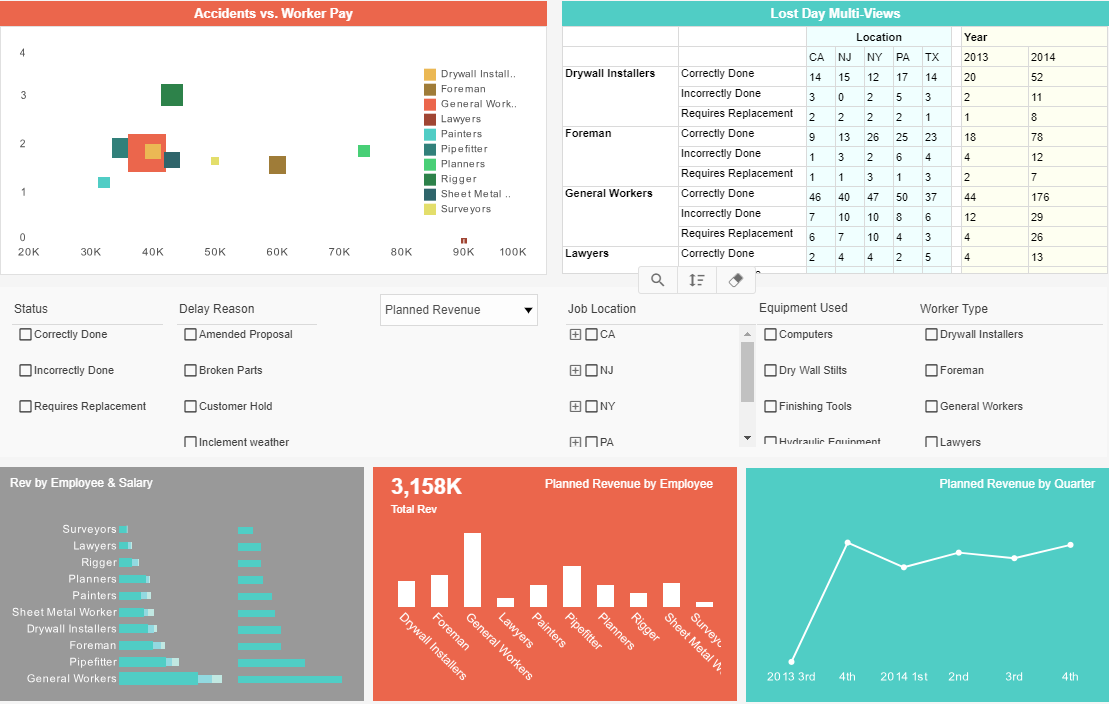InetSoft Webinar: A Data Mashup Driven BI Platform
This is the continuation of the transcript of a Webinar hosted by InetSoft on the topic of "Improving Corporate Performance Management." The speaker is Abhishek Gupta, Product Manager at InetSoft.
If you can integrate all of your systems, and we have plenty of them, if you can integrate them into one central database or use a data mashup driven BI platform like InetSoft’s, and then have that information spread out, that’s great. It’s a delicate balance. I think it’s going to be challenging to eventually get there, but we are trying to do that sort of in small steps. There is value. The information that you can get whenever, wherever you want has significant value.
And then I also think there is something that comes along with the sort of the user. We talked about engaging with our guests and our customers. We also have to make sure that we are engaging with our employees or managers, that we are giving them, just like we give a customer, the choice of experiencing the company the way they want. We have to be open to give our young workforce in the restaurants the choice on how they want to see information.
Because people learn differently, people have different learning styles, and this group of managers that we are hiring or that are coming through our ranks in the restaurants are using this technology that has been their way of life, and it’s somewhat new to most of us, but it’s been their way of life. So you have to give them a choice to look at data.
If you want them to perform and want them to react to the business, you have got to give them the choice on how they want to view the data. So whether they want it on their mobile phone because they can get it when they want, give it to them on their mobile phone because they will embrace it, if you give them the choice on how they want to see the data.
And then the next piece is, again it’s just not for business intelligence reporting and what not, we have used these devices for training tools. We have used these devices for feedback. So there is so much to be done with the information on these mobile devices that sort of goes beyond the key metrics. It’s about engaging your employees, about engaging your customers.
Imagine you are taking all these experiences and knowledge to a much larger concern. Let’s say the company is in the B2B world. Can you see this data being integrated with current systems to provide insight about the forecast and more nimble planning in much larger organizations? What might be the impediments? What might lie ahead for these organizations?
Most of the data, about 80% of the data comes from that point-of-sales system and that point-of-sales system is being fed by other systems. So there is 20% of our information that comes outside the experience of the ordering process. That information comes through, and we are able to really use that information in a meaningful way. It’s tightly integrated with our back office systems and our back office systems house scheduling for our employees. They house rolling forecasts on a week-to-week basis, so we are able to use that data that we pull and have our back office system set up a forecast for the next week or the next month.
A big piece of our business is employees, the labor that we spend on. It’s about a third of our P&L, so this allows us to take historical data and match that against current trends, match that against how many hours we are deploying for a given day, for a given week. All of that integration works, and we analyze it, and then it gives us information to act on.
The manager doesn’t have to do all of the work themselves. They are getting 80% of the information, and then 20% of their job becomes making modifications and changes to those forecasts based on their knowledge of the business that they work in everyday. We try to get them the head start and then have them use the rest of their business intelligence to make the decisions.
What Does Data Mashup Driven BI Platform Mean?
What Is a Data Mashup?
- Definition: A data mashup integrates heterogeneous data sources, such as databases, spreadsheets, APIs, and web services—into a unified, analyzable dataset.
- Flexibility: Unlike rigid ETL processes, mashups allow users to dynamically combine and reshape data on the fly.
- User Empowerment: Power users and analysts can create their own mashups without waiting for IT to predefine relationships or schemas.
What Makes a BI Platform “Mashup Driven”?
- Self-Service Capabilities: Users can define, combine, and visualize data blocks independently, often through drag-and-drop interfaces or low-code environments.
- Real-Time Integration: Data from CRM, ERP, social media, and other sources can be mashed up in real time for immediate insights.
- Agility Over Governance: While traditional BI emphasizes a “single version of truth,” mashup-driven platforms prioritize agility and responsiveness to evolving business questions.
Key Benefits
| Benefit | Description |
|---|---|
| Speed & Agility | Quickly combine and analyze data without waiting for IT intervention. |
| Customization | Tailor dashboards and reports to specific roles or use cases. |
| Improved Collaboration | Teams can share enriched datasets for cross-functional insights. |
| Better ROI | Maximizes value from existing tools like Google Analytics, CRM, etc. |
| Enhanced Decision-Making | Enables granular and holistic views of business operations. |
Example Use Case
Imagine an e-commerce company combines:
- Google Analytics data (customer behavior),
- ERP data (transaction history),
- Social media sentiment analysis.
- Identify top-performing products,
- Understand how social trends affect sales,
- Optimize ad campaigns—all in one dashboard.


